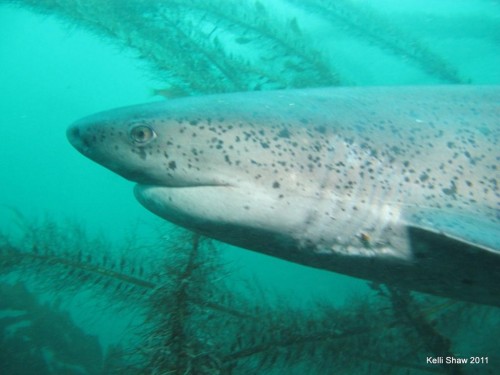Celebrating Shark Week with Sevengill Sharks
Posted on Categories Discover Magazine

This week is Shark Week so we wanted to celebrate by returning to three posts written about Sevengill Sharks and ways you can support their conservation through the Sevengill Sharks Tracking Project. The first post (seen below) was published in 2013 with others following in 2015 and 2016. Not really into carnivorous fish? Check out SciStarter’s Project Finder! With 1100+ citizen science projects spanning every field of research, task and age group, there’s something for everyone!By Ashley Rose Mehlenbacher
Emerging technologies have a profound effect on how citizen scientists conduct their work. An underwater creature of ancient lineage helps to tell this modern story of technology’s importance to citizen science. Notorynchus cepedianus, the sevengill shark, of the ancient Hexanchidae family (cow sharks), features seven gill slits and a single dorsal fin, giving a prehistoric visage to this predator. Despite its uncanny appearance, this shark is one that has demonstrated little aggression toward humans, with fewer than five wild attacks accounted for since the 16th century.
In fact, divers have been increasingly encountering these creatures off the coast of San Diego. Harmless as these encounters are, they are spectacular and haunting, as Michael Bear, founder of the Sevengill Shark Tracking Project, would tell you. In the summer of 2009 he experienced the sevengill himself, after hearing rumors of its increased presence in the San Diego coastal area, when a giant seven-foot long (2.1 meters) sevengill glided between him and a dive-buddy. Describing that moment, Bear says that, “it is a humbling experience being in the presence of one of these large, apex predators––they have a grace and a majesty about them that is unforgettable.” But are these encounters an indicator of increasing sevengill populations or a product of increased numbers of divers––or perhaps divers with attentive eyes?
For many years few sightings were reported, but more anecdotal reports began to trickle in, and, Bear tells us, the “period that we really began hearing a significant increase in reports was 2009-2010.” Bear wanted to know more (and for good reason). The sevengill is a high-order or apex marine predator and therefore may be important to ecological structure, interactions, and ecosystem management (Williams et al., 2011 and 2012). In 2010 Bear’s project began to take shape.
The Sevengill Shark Tracking Project is a citizen science effort to collect baseline population data on the sevengill. Though it started out small, the project has grown, partnering with the Shark Observation Network. Now a single global database aggregates data on sightings to help determine baseline population information. Though a study of this kind can take many years, Bear’s project already has important insights for citizen science projects, especially in the use of new technologies.
Bear has developed the Sevengill Shark Tracking project’s smartphone app, called “Shark Observers.” It’s available for Android devices and allows divers to log sightings once they’ve surfaced and, presumably, dried off. While this particularly benefits sevengill tracking, the application actually allows users to submit logs for any kind of shark encounter to the Shark Observation Network database. This application can be downloaded through Google Play.
In addition to the app and database cataloguing the date, time, water temperature, and sightings––with separate databases for photographic and video recordings—the project has also started to use pattern recognition technology to identify individual sharks. This is an inexpensive alternative to costly and labor-intensive shark tagging.
With the I3S pattern recognition algorithm, which is also used for mapping star patterns on Whale Sharks, the sevengill project uses collected high definition photos to track individual sharks by their “freckling” pattern. Using the algorithm, Bear is able to identify the unique patterning on individual sevengill sharks. Eight individuals have been identified and tracked using this method, allowing Bear and other researchers to track the return of these sharks each year. What is crucial for this approach, Bear tells us, “is to have high resolution photographs where the freckling pattern is visible.” While crucial, this technological demand is not a significant barrier for most of the diver-citizen scientists, says Bear, since “most divers these days are using hi def cameras anyway.”
Since the motivation for Bear’s project was to determine baseline populations, knowing more about the number of sharks that are present and returning to the area becomes crucial. Tracking individuals helps to sort out the matter of whether the population of sharks or the population of divers (and therefore reported sightings) is increasing. Securing more data is essential to draw reasonable conclusions about these populations and so the Sevengill Shark Sightings project continues to collect sightings, including those with video and photographic data, submitted by divers in the San Diego area. Specifically, Bear’s project is interested in the population data over a 5- to 10-year period, asking whether the population density appears to stay relatively static or if there are notable changes.
In addition to these research interests, science education is built into this citizen science model. Bear hopes to train local divers in identification techniques for the sevengill shark. The Sevengill Shark Sighting project provides an interesting example of how technology can help citizen scientist organize anecdotal data into important scientific datasets.
Dr. Ashley Rose Mehlenbacher is an assistant professor specializing in rhetoric and science communication at the University of Waterloo.
References
Williams, GD, Andrews, KS, Farrer, DA, Bargmann, GG, and Levin, PS. (2011). Occurrence and biological characteristics of broadnose sevengill sharks (Notorynchus cepedianus) in Pacific Northwest coastal estuaries. Environmental Biology of Fishes 91: 379–388. doi: 10.1007/s10641-011-9797-z.
Williams GD, Andrews KS, Katz SL, Moser ML, Tolimieri N, Farrer DA, Levin PS. (2012).
Scale and pattern of broadnose sevengill shark Notorynchus cepedianus movement in
estuarine embayments. Journal of Fish Biology 80(5): 1380–1400. doi:
10.1111/j.1095-8649.2011.03179.x
Photo: Michael Bear; photo credit Kelli Shaw, 2011.